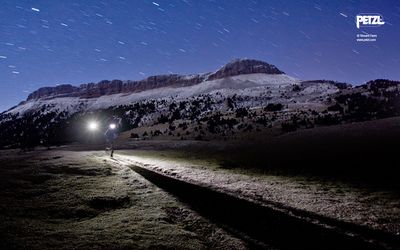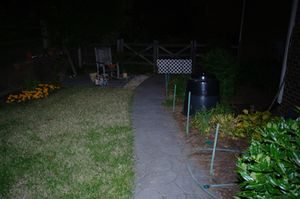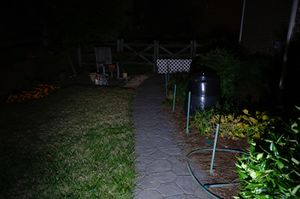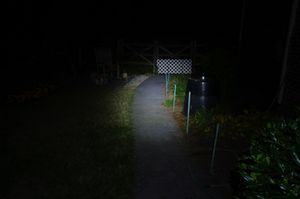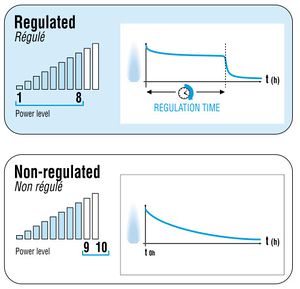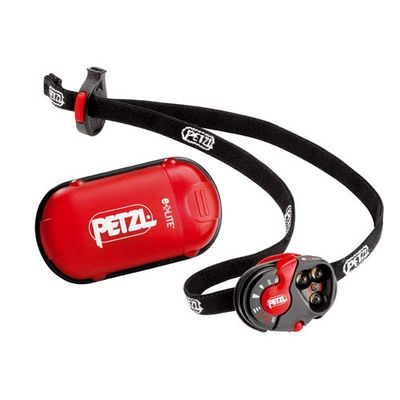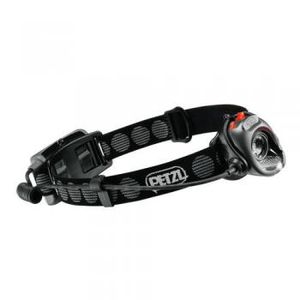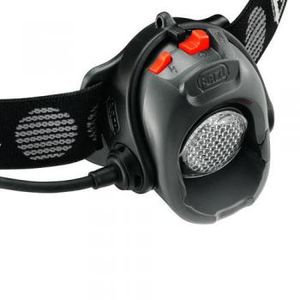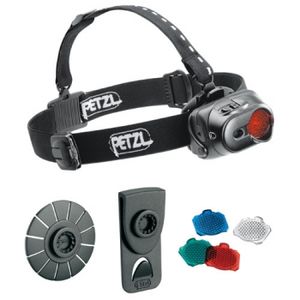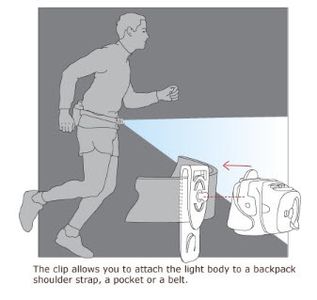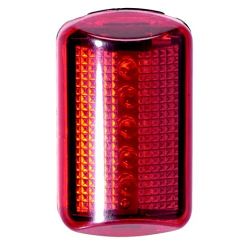Test
There are many lights available for runners depending on your need, but some are far better than others. Below is a summary of my recommendations, followed by a look at the key factors to look for in a light and a comparison of the lights.
Contents
[hide]1 Where to Buy
2 What to look for
There are four factors to consider with a running light; location, the beam pattern, regulation and brightness.
2.1 Location
2.1.1 Handheld
I do not recommend handheld lights for several reasons. The biggest problem is that keeping the light pointed in the right direction changes your arm movement and messes up your Running Form. In addition, handheld lights occupy one of your hands making it tricky to do anything in the dark, though knuckle lights overcome this.
2.1.2 Head Mounted
Because a head mounted light is aligned with your eyes, it's hard to see the shape of the ground. This is best seen in the images above. Head mounted directs the light where you point your head, making it easier to see where you're going. Head mounted also works better for directing the light to things in your hands, like putting on gloves or looking at your Watch. Head mounted lights are better at showing up branches or spider webs that are about to hit your face.
2.1.3 Waist Mounted
Waist mounted lights are much better in the rain or dusty conditions. With a head mounted light, the beam picks up the rain or dust in front of your face, making it hard to see. I run with BOTH head and waist mounted lights in most conditions.
2.2 Beam Pattern – Spot vs Diffuse
Most lights project a narrow spot beam, which illuminates a longer distance. Many of the Petzl lights have a diffuser than can be moved in front of the light to provide an even illumination, though it does not reach so far.
2.3 Regulation – Light output over time
With a regulated light the light intensity will stay constant over most of the life of the battery, and it will then grow rapidly dim. This can be seen graphically below. The regulation is nice, but when the end of the regulation period is reached, the light intensity can drop very quickly, so you need to have spare batteries with you if you expect to run out of power.
2.4 Brightness – Brighter is not always better
The brightness you need depends on your situation. In many cases you just need to see what's immediately ahead of you, so brightness is not critical. If you're on trails, then a really bright light can help see what direction a trail is taking, or help with navigation. Many times I've found that having a dim light can work best, as it helps me see what's ahead without compromising my night vision, allowing me overall better visibility. A very bright light will create a pool of light that can become mentally confining and isolating. Having a light that will go both very bright and very dim is ideal, and the Petzl MYO RXP stands out for this.
3 Light Reviews
3.1 Fenix HP30
xxx
3.2 Fenix HP25
xxx
3.3 Petzl e+Lite
Xxx The Petzl e+Lite worth considering as a backup light, but don't use this as your primary light unless weight is of paramount importance. It's not bright enough and the lithium batteries are pricy. However, it will fit in the pocket of my shorts, so it makes a great 'oops' light.
xxx
3.4 Petzl Myo RXP
Xxx The Petzl MYO RXP is a regulated light, as described above. The light will flash a few times when the battery drops too low, which gives you some warning before it runs out of power. The RXP also support brighter output that is unregulated, which is useful when you need a lot of light for a short period of time. The regulated output can be used so that you will have power for an overnight run, and on its lowest power setting it will run for 96 hours. The RXP is also nice because it can output a very dim light. I've found this works well near dawn, where the light from the RXP on its lowest output and with the diffuser is enough to see by, but allows my eyes to adjust so that I can see a little further using the available light. I've found the RXP works well in heavy rain as long as it is in the normal position. If you run with it wrapped around your hand, the rain can get in the underside and cause problems until it dries out. The RXP uses AA batteries, so it is a little heavy, but having the batteries on the back balances things quite well. It also allows the batteries to stay warmer in cold conditions if you wear it with the back under a hat; you'll probably need two hats to make that work.
- Petzl MYO RXP
xxx
3.5 Petzl Tikka RXP
xxx
3.6 Petzl Tactikka
Xxx The Petzl Tactikka XP Adapt is not as bright as thePetzl MYO RXP , but it can be waist mounted. This works best with compression shorts/tights to prevent the light wobbling around. I've found this works far better on trails than a head mounted light. The XP Adapt uses AAA batteries, so it's lighter than the Petzl MYO RXP. If you don't need the waist mounting, then the Petzl Tactikka XP is the same light without the adapter kit, and it's quite a bit cheaper than the MYO RXP.
- Petzl MYO RXP
xxx
4 Lights Comparison
| Light | Link | Weight | Weight on Head | High Brightness (absolute) | High Brightness (perceived) | Battery Life on High | Battery pack | Waist Mounted? | Waterproof | Rear Light | Regulated? |
|---|---|---|---|---|---|---|---|---|---|---|---|
| Black Diamond Sprinter | Error: Could not parse data from Amazon! | 3.8 | 3.8 | 180 | 5.5 | 6h | Rear | No | Splashproof (IPX4) | Yes | Yes |
| Foxelli MX500 | Error: Could not parse data from Amazon! | 4.7 | 4.7 | 250 | 6.2 | 8h | Rear | No | Yes, IP7 (waterproof 1 meter for 30 minutes) | No | No |
| GoMotion Orion | Not yet on Amazon | 6.0 | 0.0 | 30 | 3.1 | 8h | Waist Mounted | Yes | No (IPX3, semi-splashproof) | Yes | No |
| Fenix HP30 | Error: Could not parse data from Amazon! | 13.8 | 5.9 | 750 | 8.9 | 3h50 | Waist Mounted | Maybe | Mostly, (IPX6, low pressure jets of water) | No | Yes |
| Fenix HP25 | Error: Could not parse data from Amazon! | 9.9 | 9.9 | 500 | 7.8 | 7h30 | Rear | No | Mostly, (IPX6, low pressure jets of water) | No | Yes |
| Petzl e+Lite | Error: Could not parse data from Amazon! | 1.6 | 1.0 | 15 | 2.4 | 55h | N/A | No | Yes (IP67, waterproof 1 meter for 30 minutes) | No | No |
| Petzl Tikka RXP | Error: Could not parse data from Amazon! | 4.0 | 4.0 | 180 | 5.5 | 2h30 | Front | No | Splashproof (IPX4) | No | Yes |
| Petzl Tactikka XP Adapt | Discontinued | 3.1 | 4.0 | 8 | 2.0 | 2h30 | Front | Yes | Splashproof (IPX4) | No | No |
| Petzl MYO RXP | Error: Could not parse data from Amazon! | 5.8 | 5.8 | 180 | 5.5 | 1h20 | Rear | No | Splashproof (IPX4) | No | Yes |
| Coast HL6 | Error: Could not parse data from Amazon! | 4.4 | 4.4 | 90 | 4.4 | 1h30 | Rear | No | "Weather Resistant" | No | No |
| GRDE Zoomable | Error: Could not parse data from Amazon! | 9.7 | 9.7 | 350 | 6.9 | 4h | Rear | No | Maybe ("Living Waterproof" claimed) | No | No |
5 Light Gallery
Light Gallery - Beams This is a gallery of real world performance of these lights. A photo was taken for each setting on each light to display the differences.
6 Other Thoughts
6.1 Safety lights
A flashing red light clipped to the back of your waist band is a worthwhile addition for running in urban situations. The Nathan Clip-On Safety Strobe is less than $10.
6.2 Batteries
I use Enloop Low Self Discharge rechargeable batteries in my lights. The 'low self discharge' means that they won't go flat if you leave them in a drawer for a few weeks. I got the La Crosse Technology BC-700 Alpha Power Battery Charger which is more expensive than many at $50, but well worth it for keeping the batteries healthy.
